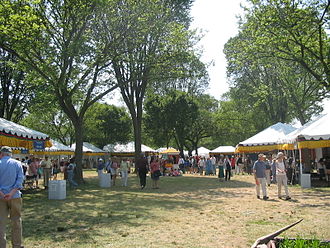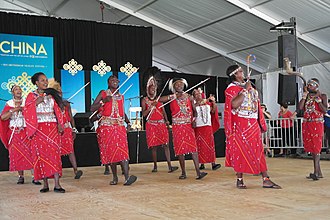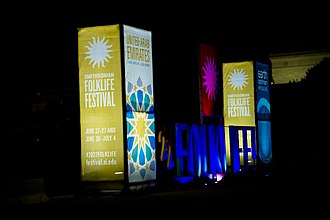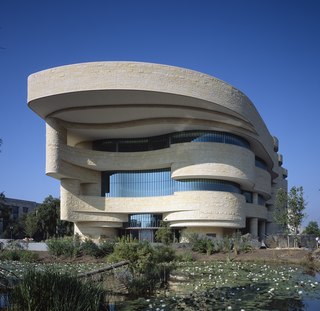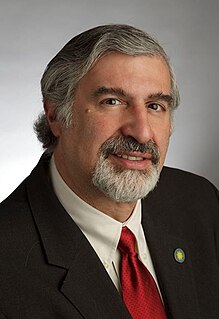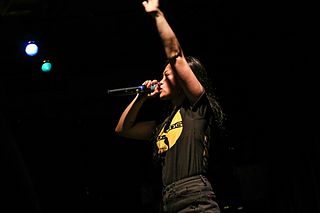| No. | Year | Topics |
|---|
| 53 | 2019 [3] | Social Power of Music [4] (Festival shortened to two days and downscaled due to effects of the 2018–19 United States federal government shutdown. [5] ) |
| 52 | 2018 [6] | Armenia: Creating Home; [7] Catalonia: Tradition and Creativity from the Mediterranean; [8] Sisterfire: Roadwork 40th Anniversary Concert [9] |
| 51 | 2017 [10] | Circus Arts; [11] On The Move: Migration Across Generations; [12] 50 Years, 50 Objects: Storied Objects from the Smithsonian Folklife Festival; [13] 50th Anniversary: 1967-2017 [14] |
| 50 | 2016 [15] | Basque: Innovation by Culture; [16] Sounds of California [17] |
| 49 | 2015 [18] | Perú: Pachamama [19] |
| 48 | 2014 [20] | China: Tradition and the Art of Living; [21] Kenya: Mambo Poa [22] |
| 47 | 2013 [23] | Hungarian Heritage: Roots to Revival; One World, Many Voices: Endangered Languages and Cultural Heritage; The Will to Adorn: African American Diversity, Style and Identity [24] |
| 46 | 2012 [25] | Campus and Community: Public and Land-grant Universities and the USDA at 150; Citified: Arts and Creativity East of the Anacostia River; Creativity and Crisis: Unfolding The AIDS Memorial Quilt [26] |
| 45 | 2011 [27] | Colombia: The Nature of Culture; Peace Corps: 50th Anniversary; Rhythm and Blues: Tell It Like It Is [28] |
| 44 | 2010 [29] | Asian Pacific American Connections: Local Lives, Global Ties; México; Smithsonian Inside Out; Special Events: Haiti, Ralph Rinzler Memorial Concert, George Wallace, Smithsonian 3D [30] |
| 43 | 2009 [31] | Giving Voice: The Power of Words in African American Culture; Las Américas: Un Mundo Musical (The Americas: A Musical World); Wales Smithsonian Cymru [32] [33] |
| 42 | 2008 | Bhutan: Land of the Thunder Dragon; NASA: Fifty Years and Beyond; Texas: A Celebration of Music, Food, and Wine [34] |
| 41 | 2007 | Mekong River: Connecting Cultures; Northern Ireland at the Smithsonian; Roots of Virginia Culture |
| 40 | 2006 | Alberta at the Smithsonian; Been in the Storm So Long: New Orleans Evening Concert Series; Carriers of Culture: Living Native Basket Traditions; Nuestra Música: Latino Chicago |
| 39 | 2005 | Food Culture USA, Forest Service, Culture, and Community; Oman: Desert, Oasis, and Sea; Nuestra Música: Music in Latino Culture |
| 38 | 2004 | Haiti: Freedom and Creativity from the Mountains to the Sea; Nuestra Música: Music in Latino Culture; Water Ways: Mid-Atlantic Maritime Communities |
| 37 | 2003 | Appalachia: Heritage and Harmony; Scotland at the Smithsonian; Mali: From Timbuktu to Washington |
| 36 | 2002 | The Silk Road: Connecting Cultures, Creating Trust, including exhibits on Venice, Istanbul, Samarkand, nomads, Xi'an, truck art from Pakistan, and Nara [35] [36] |
| 35 | 2001 | New York City at the Smithsonian, Masters of the Building Arts; Bermuda Connections |
| 34 | 2000 | El Rio, Tibetan Culture: Beyond the Land of Snows; Washington, D.C.: It's Our Home |
| 33 | 1999 | Celebrating New Hampshire's Stories; Gateways to Romania; South Africa: Crafting the Economic Renaissance of the Rainbow Nation |
| 32 | 1998 | Wisconsin; Rio Grande/rio Bravo Basin; Baltic Nations: Estonia, Latvia, and Lithuania; Pahiyas: A Philippine Harvest; Folkways 50th |
| 31 | 1997 | Mississippi Delta; African Immigrant Folklife; Sacred Sounds |
| 30 | 1996 | Iowa-Community Style; American South; Working at the Smithsonian |
| 29 | 1995 | Cape Verdean Connection; Russian Roots/American Branches; Heartbeat: Voices of First Nations Women;Czech Republic: Tradition and Transformation |
| 28 | 1994 | Masters of Traditional Arts: National Heritage Fellowships, The Bahamas, Thailand, Culture and Development in Latin America and the Caribbean |
| 27 | 1993 | US-Mexico Borderlands, American Social Dance, metro Music, Kids' Stuff |
| 26 | 1992 | New Mexico, Creativity and Resistance: Maroon Culture in the Americas, Workers at the White House, the Changing Soundscape in Indian Country |
| 25 | 1991 | Family Farming in the Heartland; Indonesia: Forest, Field, and Sea; Land in Native American Cultures; Roots of Rhythm and Blues: the Robert Johnson Era |
| 24 | 1990 | US Virgin Islands, Senegal, Musics of Struggle |
| 23 | 1989 | Hawaii, Cultural Conservation: American Indian Program; "Les Fetes Chez Nous": France and North America, Quincentenary Program: The Caribbean-Cultural Encounters in the New World |
| 22 | 1988 | Ingenuity and Tradition: The Commonwealth of Massachusetts; Cultural Conservation: American Folklore Society Centennial; Migration to Metropolitan Washington: Making a New Place Home; Music from the Peoples of the Soviet Union; Music Festival Stage: Bluegrass |
| 21 | 1987 | Michigan; Cultural Conservation and Languages: America's Many Voices; Metropolitan Washington |
| 20 | 1986 | Tennessee; Japan; Cultural Conservation: Traditional Crafts in a Post-industrial Age; American Trial Lawyers; 20th Anniversary Music Stage |
| 19 | 1985 | Louisiana; India: Mela!; Cultural Conservation: Makah and Puerto Rican mask makers; African American cornrowers, Kmhmu craftsmen, Seneca basket makers, Appalachian balladry, Cajun music, cowboy music, song, and poetry, Irish music, Mayan marimba music Mayan Indian weaving |
| 18 | 1984 | Alaska, The Grand Generation: Folklore and Aging, Black Urban Expressive Culture from Philadelphia |
| 17 | 1983 | New Jersey, France, Occupational Culture: Flight, NEA: National Heritage Fellowship Awards |
| 16 | 1982 | Oklahoma, Korea, Children's Program, National Endowment for the Arts Program |
| 15 | 1981 | Regional America: Southeastern U.S. music and crafts, Northeastern music and dance; Native American Program: Ojibwa Indians; Old Ways in the New World: South Slavic Americans; Energy and Community: Adobe architecture; Children's Program; Folklore of the Deaf; American Tent Show, National Endowment for the Arts Program |
| 14 | 1980 | Old Ways in the New World: Caribbean Americans, Southeast Asian Americans, Finnish Americans; Energy and Community: Folk housing and energy efficiency, community activities, food preservation; American Talkers: Auctioneers, pitchmen, street criers |
| 13 | 1979 | Energy and Community: Native American architecture; Folklore in Your Community; Children's Program; Medicine Show |
| 12 | 1978 | Native American Community: San Juan Pueblo of New Mexico; Occupational Community: Organ builders, sleeping car porters, sharecroppers; Energy and Community: Oil and coal industry workers; Ethnic Community: Ellis Island and American Immigration; Regional Community: Chesapeake Bay, Smith Island; Mexican Communities |
| 11 | 1977 | Virginia; Native American Program: Ojibwa, Tolowa, San Juan Pueblo, Navajo, Seneca; Working Americans: Folklore in Your Community |
| 10 | 1976 | Regional America: Northeast, Great Lakes, South, Upland South, Heartland, Great West, Pacific Northwest, Pacific Southwest; Native American Program: Tribes from the Northeast, Southeast, Southern Plains, Prairie, Northern Plains, Northwest Coast, Southwest, Plateau, Basin, Northern California, Arctic; Working Americans; Old Ways in the New World; Children's Program; Family Folklore |
| 9 | 1975 | Regional America: Northern Plains, California Heartland; Native American Program: Iroquois Confederacy; Working Americans: Railroad workers, aircraft employees, truckers, seafarers; Old Ways in the New World: Germany, Italy, Lebanon, Japan, Mexico; African Diaspora: Jamaica, Ghana, Haiti; Children's Program; Family Folklore |
| 8 | 1974 | Mississippi; Native American Program: California tribes; Working Americans: Graphic artists, radio operators (amateur/commercial); Old Ways in the New World: Sweden, Norway, Finland, Tunisia, Greece; African Diaspora: Ghana, Trinidad and Tobago, Nigeria, Caribbean; Children's Program; Family Folklore; Performance: Evolution of American Folk Music |
| 7 | 1973 | Kentucky; Native American Program: Northern Plains Indians; Working Americans: Plumbers, carpenters, electricians, stonemasons, lathers, bricklayers, plasterers, millwrights, operating engineers, pipe fitters, sheet metal workers, steam fitters; Old Ways in the New World: Britain, Yugoslavia |
| 6 | 1972 | Maryland; Native American Program: Southwest Indians; Labor Program: ILGWU, lithographers and photoengravers, carpenters and joiners, molders and allied workers; Performance: Chicago blues, old-time country blues, gospel, First Annual Fiddlers' Convention |
| 5 | 1971 | Ohio; Native American Program: Northwest Coast Indians; Labor Program: Meat cutters and butchers; bakery and confectionery workers; glass bottle blowers; bridge, structural, and ornamental iron workers; Performance: Puerto Rican music and dance, Cajun music, country music, ragtime, shouts, jubilees, work songs, blues, Caribbean music and dance, rock and roll, rhythm and blues, old-time banjo and fiddle music |
| 4 | 1970 | Arkansas; Native American Program: Southern Plains Indians; Performance: Spanish, Irish, and Scottish bagpipers, country, bluegrass music, southern blues, Sacred Harp, Portuguese-American Fado musicians, Chinese dragon dancers, shouts, spirituals, jubilees, string bands, East European folk songs; Crafts: Dairy traditions |
| 3 | 1969 | Pennsylvania; Performance: French singers from New Hampshire and Louisiana, Grand Ole Opry performers, Turkish, Afro-Cuban, Greek singers and dancers, ballad singers, string bands, fife and drum bands, blues, shouts, jubilees, spirituals; Crafts: Sheep shearing and wool processing, corn culture, Seminole Indian crafts, carvers and toy makers, doll makers, blacksmiths, basket maker, potter; Toby Show: Traditional Touring Tent Theater |
| 2 | 1968 | Texas; Native American Program: Lummi Indians; City-Country Area: Blues, bluegrass, jazz, gospel, Cajun, Basque, Indian, dancers, ballad singers; Crafts: Butter churning, sheep shearing, soap, candy, sorghum making, milling |
| 1 | 1967 | Performance: American fife and drum groups; brass bands; string bands; gospel; shouts; jubilees; spirituals; Puerto Rican music; New Orleans jazz; Cajun music; ballads; Mesquakie Indian music; blues; country music; polka music; cowboy songs; clogging; Scottish, Russian, Irish dancers; Chinese New Year's Pantomime; King Island Eskimo dancers; dance of Galicia; Crafts: American basket makers, carvers, doll makers, needleworkers, potters, blacksmith, silversmith, spinners, weavers |
